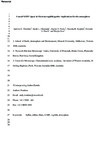A small S-MIF signal in Martian regolith pyrite: Implications for the atmosphere
| dc.contributor.author | Tomkins, AG | |
| dc.contributor.author | Alkemade, SL | |
| dc.contributor.author | Nutku, SE | |
| dc.contributor.author | Stephen, Natasha | |
| dc.contributor.author | Finch, MA | |
| dc.contributor.author | Jeon, H | |
| dc.date.accessioned | 2020-07-30T11:07:06Z | |
| dc.date.available | 2020-07-30T11:07:06Z | |
| dc.date.issued | 2020-07-22 | |
| dc.identifier.issn | 0016-7037 | |
| dc.identifier.issn | 1872-9533 | |
| dc.identifier.uri | http://hdl.handle.net/10026.1/16123 | |
| dc.description | keywords: Sulfur, sulfate, Mars, S-MIF, regolith, atmosphere | |
| dc.description.abstract |
The past Martian atmosphere is often compared to the Archean Earth’s as both were dominated by CO2-rich and O2-poor chemistries. Archean Earth rocks preserve mass-independently fractionated sulfur isotopes (S-MIF; non-zero Δ33S and Δ36S), originating from photochemistry in an anoxic atmosphere. Thus, Martian crustal rocks might also be expected to preserve a S-MIF signature, providing insights into past atmospheric chemistry. We have used secondary ion mass spectrometry (SIMS) to investigate in situ, the sulfur isotope systematics of NWA 8171 (paired to NWA 7034), a Martian polymict breccia containing pyrite that formed through hydrothermal sulfur addition in a near-surface regolith setting. In this meteorite, pyrite grains have a weighted mean of Δ33S of -0.14 ± 0.08 ‰ and Δ36S = -0.70 ± 0.40 ‰ (2 s.e.m.), so the S-MIF signature is subtle. Sulfur isotope data for four additional shergottites yield Δ33S values that are not resolvable from zero, as in previous studies of shergottites. At first glance the result for the polymict breccia might seem surprising, but no Martian meteorite yet has yielded a S-MIF signature akin to the large deviations seen on Earth. We suggest that S-MIF-bearing aerosols (H2SO4 and S8) were produced when volcanic activity pushed a typically oxidising Martian atmosphere into a reduced state. After rain-out of these aerosols, S8 would tend to be oxidised by chlorate, dampening the S-MIF signal, which might be somewhat retained in the more abundant photolytic sulfate. Then in the regolith, mixing of aqueous surface-derived sulfate with igneous sulfide (the latter with zero MIF), to form the abundant pyrite seen in NWA 8171, would further dampen the S-MIF signal. Nonetheless, the small negative Δ33S anomalies seen in Martian meteorites imply that volcanic activity was sufficient to produce a reducing atmosphere at times. This volcanically-driven atmospheric evolution would tend to produce high levels of carbonyl sulfide (OCS). Given that OCS is a relatively long-lived strong greenhouse gas, the S-MIF signal implies that volcanism periodically generated warmer conditions, perhaps offering an evidence-based solution to the young wet Mars paradox. | |
| dc.format.extent | 59-75 | |
| dc.language | en | |
| dc.language.iso | en | |
| dc.publisher | Elsevier BV | |
| dc.subject | Sulfur | |
| dc.subject | Sulfate | |
| dc.subject | Mars | |
| dc.subject | S-MIF | |
| dc.subject | Regolith | |
| dc.subject | Atmosphere | |
| dc.title | A small S-MIF signal in Martian regolith pyrite: Implications for the atmosphere | |
| dc.type | journal-article | |
| dc.type | article | |
| plymouth.author-url | https://www.webofscience.com/api/gateway?GWVersion=2&SrcApp=PARTNER_APP&SrcAuth=LinksAMR&KeyUT=WOS:000579790500005&DestLinkType=FullRecord&DestApp=ALL_WOS&UsrCustomerID=11bb513d99f797142bcfeffcc58ea008 | |
| plymouth.volume | 290 | |
| plymouth.publisher-url | http://www.sciencedirect.com/science/article/pii/S0016703720304427 | |
| plymouth.publication-status | Published | |
| plymouth.journal | Geochimica et Cosmochimica Acta | |
| dc.identifier.doi | 10.1016/j.gca.2020.07.022 | |
| plymouth.organisational-group | /Plymouth | |
| plymouth.organisational-group | /Plymouth/Faculty of Science and Engineering | |
| plymouth.organisational-group | /Plymouth/Faculty of Science and Engineering/School of Geography, Earth and Environmental Sciences | |
| plymouth.organisational-group | /Plymouth/Faculty of Science and Engineering/School of Geography, Earth and Environmental Sciences/SoGEES - Manual | |
| plymouth.organisational-group | /Plymouth/REF 2021 Researchers by UoA | |
| plymouth.organisational-group | /Plymouth/REF 2021 Researchers by UoA/UoA07 Earth Systems and Environmental Sciences | |
| plymouth.organisational-group | /Plymouth/Users by role | |
| plymouth.organisational-group | /Plymouth/Users by role/Academics | |
| dcterms.dateAccepted | 2020-07-10 | |
| dc.rights.embargodate | 2021-7-22 | |
| dc.identifier.eissn | 1872-9533 | |
| dc.rights.embargoperiod | Not known | |
| rioxxterms.versionofrecord | 10.1016/j.gca.2020.07.022 | |
| rioxxterms.licenseref.uri | http://www.rioxx.net/licenses/all-rights-reserved | |
| rioxxterms.licenseref.startdate | 2020-07-22 | |
| rioxxterms.type | Journal Article/Review |


